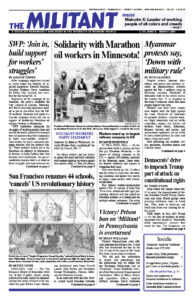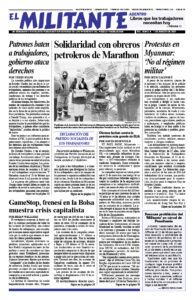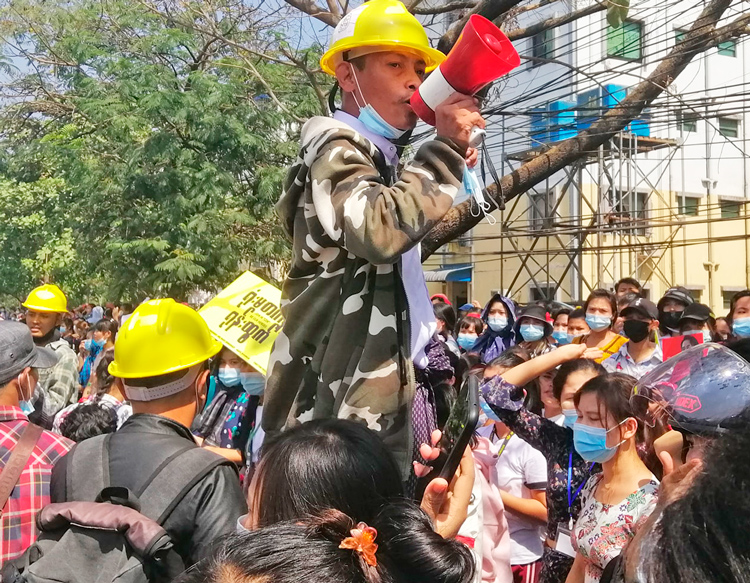Despite arrests, internet shutdowns, and police and military assaults on demonstrators, protests against the Feb. 1 military coup in Myanmar continue. Hundreds of thousands took to the streets across the country Feb. 17, in response to the army’s ludicrous claim that most people support the coup.
Workers and their trade unions have helped lead the fight against the coup. Hundreds of thousands of garment workers, railroad workers, flight attendants and air traffic controllers, miners, bus drivers, oil workers, bank tellers, fishermen, farmers, doctors and nurses, and government employees are on strike or have joined protests in cities and towns, large and small.
Also protesting are students, artists, musicians, Buddhist monks and Catholic clergy.
“Workers were already angry, they were already activated,” Moe Sandar Myint, 37, leader of the Federation of General Workers Myanmar, told Reuters Feb. 12. She was referring to union fights for higher wages and better conditions that were taking place prior to the coup. The federation organizes many of the more than 600,000 garment workers, who produce largely for markets abroad, including Gap in the U.S.
“Union leaders came under intense pressure from management and the police,” she said. “The only answer was to go to the streets.” Police raided her home Feb. 6, but couldn’t find her.
Moe Sandar Myint went out herself, standing on car tops to urge workers to “fight against the military dictatorship until the end.”
Protesters are demanding the release of Aung San Suu Kyi and other leaders of the National League for Democracy, the bourgeois party that won the November elections in a landslide. Gen. Min Aung Hlaing, the leader of the military, claims the results were a fraud.
Under the 2008 constitution imposed by the military, the generals appoint 25% of the seats in parliament — giving them veto power and control of the main ministries.
The military high command saw the lopsided vote as a threat, even though Suu Kyi, who became de facto head of state in 2015, has not challenged the military’s power, its lucrative control of many industries, and its hostility to the country’s ethnic minorities. In fact, she has been the most prominent apologist for the military’s savage treatment and mass expulsion of the Rohingya Muslim minority.
These national divisions are a legacy of the divide-and-rule strategy of the former British colonial rulers.
Political prisoners
Suu Kyi is under house arrest, charged at first with possessing illegally imported walkie-talkies. On Feb. 16, when she had her first hearing on the charges, she was denied assistance by her attorney and discovered the junta had added the charge that she violated COVID-19 restrictions.
Along with Burmans, the majority in Myanmar, there has been widespread participation in the protests by working people from minority ethnic groups — 40% of the population — whether or not they voted for Suu Kyi.
A group of Rohingya marching in protests in Yangon against the coup were well received, Khin Maung Lwin, who was part of the contingent, told The Atlantic.
Police and soldiers used rubber bullets and slingshots to attack protesters outside the Central Bank in Mandalay Feb. 15. In several cities cops fired water cannon and tear gas in failed attempts to quell the protests.
When police surrounded the National League for Democracy headquarters Feb. 15 in Yangon, trapping party officials inside, thousands gathered outside and the cops retreated.
Police went to a housing complex on the outskirts of Yangon to order railway workers back to work Feb. 14. The cops left after they were confronted by an angry crowd.
There have been solidarity actions around the world, especially where there are expatriate communities. An action is planned for Feb. 20 in Jackson Heights in New York City.
While the police and army have so far mostly refrained from using live ammunition, there is no guarantee that will remain the case.
In 1988 massive protests broke out against military rule, which had been imposed in 1962 and lasted until 2011. The military responded with bloody violence, killing hundreds and possibly thousands. In 2007 the regime brutally repressed a series of protests by Buddhist monks.
Neighborhood patrols
Protesters call today’s actions the Civil Disobedience Movement. They have organized to keep the protests disciplined and peaceful, seeking to give the military regime as little pretext as possible to launch deadly attacks.
The regime pardoned and released 23,000 nonpolitical prisoners last week. This had happened during the 1988 mobilizations when the generals organized some of those released to attack protest strongholds and do other provocations. Many protesters today believe the military brass is using the same tactic.
Workers in several cities have set up community watch groups, aiming to prevent provocations that could give the military an excuse to step up repression. According to Myanmar Times, so many community night patrol groups have been organized that flashlights are out of stock in Yangon’s markets.
The Yangon-based Irrawaddy newspaper reports these watch groups have stopped some suspicious activity but, having learned from 1988, they’ve prevented those detained from being mistreated. Instead, after questioning them, they hand them over to the police or send them back to their families.
Daily protests have taken place outside the Chinese Embassy, calling on Beijing to condemn the coup. So far the Chinese rulers, who are the main arms supplier to the Myanmar army and the country’s largest trading partner, have refused to do so, calling developments there “an internal affair.”


